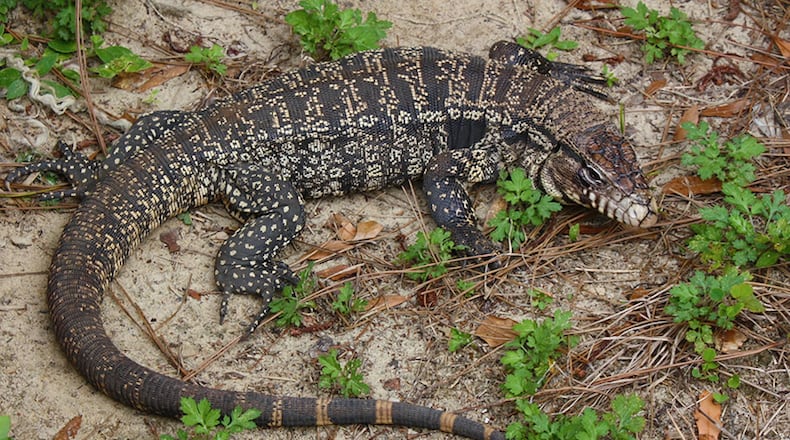SAVANNAH — Researchers are looking for a little help to remove an invasive lizard from South Georgia before it’s too late.
Argentine black and white tegus can reach 4 feet long and weigh 10 pounds or more. Adaptable and hungry, they are a significant threat to native wildlife, from gopher tortoises to ground-nesting birds such as bobwhite quail, wild turkeys and whip-poor-wills.
The Georgia Department of Natural Resources, Georgia Southern University and the U.S. Geological Survey have been working since 2018 to assess and remove what is considered a wild population of Argentine black and white tegus in Tattnall and Toombs counties. Last year seven of the nine tegus captured in Georgia came from these two South Georgia counties.
“Now four years in a row, we’ve captured animals in the wild in Georgia,” said Lance McBrayer, a Georgia Southern professor coordinating the project. “So we would say they are established. We can’t confirm that they are breeding because we have not captured a juvenile or a neonate.”
This year the emphasis is on trail cameras. The project will continue trapping and monitoring with 10 game cameras at its main site in Tattnall. But they’ll also have four sets of 10 game cameras that will be placed on other properties for two weeks at a time.
“The idea this year is to move further afield, somewhat at random around the Toombs and Tattnall counties, or adjoining counties, and put out the game cameras to see if we can document tegus that may have moved away from this main site,” McBrayer said.
McBrayer is looking for owners of at least 5 acres of likely tegu habitat who are willing to allow the Georgia Southern crew to temporarily set game cameras on their property.
“Now four years in a row, we've captured animals in the wild in Georgia. So we would say they are established. We can't confirm that they are breeding because we have not captured a juvenile or a neonate."
The team will visit the sites of landowners who volunteer their land for camera placement to see if their land offers what tegus seem to like. Right now that seems to be “edge habitat,” such as where a farm field meets a wooded area or where a road meets a scrubby area.
If a tegu is spotted, traps will be set to try to catch it.
Residents have previously responded to the call to report sightings of tegus in the wild, dead or alive. Of the seven tegus collected last year in Tattnall and Toombs counties, the public found or killed three. The seventh was a large tegu detected by a game camera on a Tattnall County farm and later trapped.
It’s unclear where the tegus in Toombs and Tattnall came from, but one theory is that they’re escaped or released pets. Daniel Sollenberger, a senior wildlife biologist with DNR’s Wildlife Conservation Section, said tegus are generalists in habitat, diet and the temperatures they can survive.
“They can live almost anywhere and eat almost anything,” Sollenberger said.
They eat eggs — including those of protected species such as American alligators — but also chow down pet food, fruits, vegetables and small animals. There is also concern tegus could spread exotic parasites to other wildlife and cause bacterial contamination of crops. Research shows, too, that these reptiles, like most, carry salmonella.
Once tegus are established and breeding, they are hard to eradicate. Florida has three confirmed populations in the wild. Trapping at one site along Everglades National Park can yield hundreds of tegus per season.
Keep Reading
The Latest
Featured


